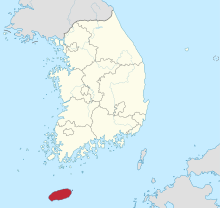
Back انتفاضة جيجو Arabic Insurrecció de Jeju Catalan Povstání na Čedžu Czech Jeju-Aufstand German Insurrección de Jeju Spanish Jeju ülestõus Estonian خیزش ججو Persian Soulèvement de Jeju French Pemberontakan Jeju ID Massacro di Jeju Italian
This article may be unbalanced towards certain viewpoints. (April 2023) |
| Jeju uprising | |||||||
|---|---|---|---|---|---|---|---|
| Part of the division of Korea | |||||||
 Map of South Korea with Jeju highlighted at the bottom in red | |||||||
| |||||||
| Belligerents | |||||||
|
Northwest Youth League Korean Youth League | ||||||
| Commanders and leaders | |||||||
|
|
| ||||||
| Casualties and losses | |||||||
| Several thousand killed[1]: 189 [a] |
162 soldiers killed 289 policemen killed 640 paramilitaries killed Total: 1,091 killed | ||||||
|
14,373 civilians killed (86% by security forces and 14% by insurgents) 30,000 total dead including combatants[2] (The governor of Jeju at the time privately reported the death toll to be around 60,000;[3] Bruce Cumings claim some source suggest death toll number 80,000;[4] Spencer C. Tucker notes estimates as high as 100,000) | |||||||
| Jeju uprising | |
| Hangul | 제주 4·3 사건 |
|---|---|
| Hanja | |
| Revised Romanization | Jeju sasam sageon |
| McCune–Reischauer | Cheju sasam sakŏn |
The Jeju uprising, known in South Korea as the Jeju April 3 incident[5] (Korean: 제주 4·3 사건), was an uprising on Jeju Island from April 1948 to May 1949. A year prior to its start, residents of Jeju had begun protesting elections scheduled by the United Nations Temporary Commission on Korea (UNTCOK) to be held in the United States-occupied half of Korea, which they believed would entrench the division of the country. A general strike was later organised by the Workers' Party of South Korea (WPSK) from February to March 1948. The WPSK launched an insurgency in April 1948, attacking police and Northwest Youth League members stationed on Jeju who had been mobilized to suppress the protests by force.[1]: 166–167 [6] The First Republic of Korea under President Syngman Rhee escalated the suppression of the uprising from August 1948, declaring martial law in November and beginning an "eradication campaign" against rebel forces in the rural areas of Jeju in March 1949, defeating them within two months. Many rebel veterans and suspected sympathizers were later killed upon the outbreak of the Korean War in June 1950, and the existence of the Jeju uprising was officially censored and repressed in South Korea for several decades.[7]: 41
The Jeju uprising was notable for its extreme violence; between 14,000 and 30,000 people (10 percent of Jeju's population) were killed, and 40,000 fled to Japan.[6][8][9][1]: 139, 193 Atrocities and war crimes were committed by both sides, but historians have noted that the methods used by the South Korean government to suppress protesters and rebels were especially cruel, with violence against civilians by pro-government forces contributing to the Yeosu-Suncheon rebellion in South Jeolla during the conflict.[1]: 171 [6][7]: 13–14 [1]: 186 Some historians and scholars, including military historian Allan R. Millett, regard the Jeju uprising as the true beginning of the Korean War.[10]
In 2003, the National Committee for Investigation of the Truth about the Jeju April 3 Incident chaired by South Korean prime minister Goh Kun described the event as a genocide.[11] South Korean president Roh Moo-hyun issued an official apology on behalf of the South Korean government.[12] In 2019, the South Korean police and the defense ministry apologized for their involvement in the massacres in Jeju.[13]
- ^ a b c d e Merrill, John (1980). "Cheju-do Rebellion". The Journal of Korean Studies. 2: 139–197. doi:10.1353/jks.1980.0004. S2CID 143130387.
- ^ Johnson, Chalmers (January 23, 2001). Blowback: The Costs and Consequences of American Empire (2000, rev. 2004 ed.). Owl Book. pp. 99–101. ISBN 0-8050-6239-4. According to Chalmers Johnson, death toll is 14,000–30,000
- ^ Cumings, Bruce. The Korean War A History (2010 ed.). Modern Library. pp. 124–125. According to the governor of Jeju at the time, the death toll was reported to be at 60,000
- ^ Cumings, 2010, p.124.
- ^ "Moon vows continued push for honor of Jeju April 3 incident victims". Yonhap News Agency. April 3, 2021. Retrieved April 5, 2021 – via The Korea Herald.
- ^ a b c Deane, Hugh (1999). The Korean War 1945–1953. San Francisco: China Books and Periodicals Inc. pp. 54–58. ISBN 0-8351-2644-7.
- ^ a b Kim, Hun Joon (2014). The Massacre at Mt. Halla: Sixty Years of Truth Seeking in South Korea. Cornell University Press. pp. 13–41. ISBN 9780801452390.
- ^ Hideko Takayama (June 19, 2000). "Ghosts of Cheju". Newsweek. Retrieved March 30, 2009.
- ^ Deane, Hugh (1999). The Korean War, 1945–1953. China Books&Periodicals, Inc. pp. 54–58. ISBN 9780141912240.
- ^ Tucker, Spencer C. (September 6, 2016). The Roots and Consequences of 20th-Century Warfare: Conflicts that Shaped the Modern World: Conflicts That Shaped the Modern World. ABC-CLIO. p. 320. ISBN 9781610698023.
- ^ The National Committee for the Investigation of the Truth about the Jeju April 3 Incident (December 15, 2003). "The Jeju April 3 Incident Investigation Report" (PDF). Office of the Prime Minister, Republic of Korea. Archived from the original (PDF) on September 21, 2015. Retrieved August 17, 2015.
{{cite web}}: CS1 maint: numeric names: authors list (link) - ^ Roh, Moo-hyun (October 31, 2003). President Roh Moo-hyun issues a state apology for the Jeju 4·3 Uprising and Massacre (PDF) (Speech). Jeju Peace Forum. Jeju City. Archived (PDF) from the original on July 2, 2023. Retrieved July 3, 2023.
- ^ AFP (April 3, 2019). "South Korean police apologize and army expresses regret for 1948 Jeju massacres". The Japan Times. Archived from the original on April 4, 2019. Retrieved May 20, 2019.
Cite error: There are <ref group=lower-alpha> tags or {{efn}} templates on this page, but the references will not show without a {{reflist|group=lower-alpha}} template or {{notelist}} template (see the help page).
© MMXXIII Rich X Search. We shall prevail. All rights reserved. Rich X Search